
James & Lister Lea was an architectural and property consultancy firm active in England between 1846 and 2001. [1]

James & Lister Lea was an architectural and property consultancy firm active in England between 1846 and 2001. [1]
Established by brothers James Lea and Lister Lea (1833-1908), the partnership was initially focused only on architecture. Together, the brothers designed buildings across Birmingham, with a heavy focus on public houses, especially towards the end of the 19th century and early 20th century.
Later in the firm's existence, it changed its name to James & Lister Lea and Sons. On 2 January 2001, the property consultancy firm merged with Bruton Knowles to produce a combined workforce of approximately 300 people. [2]
The firm had offices on Bull Street, Birmingham [3] and also in Knowle, West Midlands, although the Knowle office was sold in 1999 to agricultural surveyors Smith-Woolley. [4] In May 2000, James & Lister Lea revealed that they were looking at rebranding the company in the future. In December 2000, Bruton Knowles and James & Lister Lea agreed a merger [5] that would become effective on 2 January 2001. The merger, which did not involve any exchange of money between the two companies, led to the formation of one of the largest property consultancy firms in Birmingham.
As an architectural practice, the firm has been responsible for some of Birmingham's most recognisable public houses, many of which are now listed buildings.

The Birmingham and Fazeley Canal is a canal of the Birmingham Canal Navigations in the West Midlands of England. Its purpose was to provide a link between the Coventry Canal and Birmingham and thereby connect Birmingham to London via the Oxford Canal.
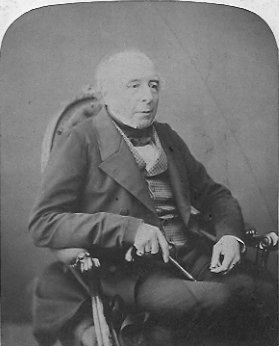
Philip Hardwick was an English architect, particularly associated with railway stations and warehouses in London and elsewhere. Hardwick is probably best known for London's demolished Euston Arch and its twin station, the original Birmingham Curzon Street, which stands today as the oldest railway terminus building in the world.

The Ikon Gallery is an English gallery of contemporary art, located in Brindleyplace, Birmingham. It is housed in the Grade II listed, neo-gothic former Oozells Street Board School, designed by John Henry Chamberlain in 1877.
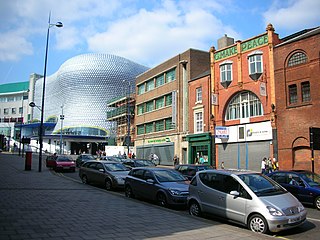
Digbeth is an area of central Birmingham, England. Following the destruction of the Inner Ring Road, Digbeth is now considered a district within Birmingham City Centre. As part of the Big City Plan, Digbeth is undergoing a large redevelopment scheme that will regenerate the old industrial buildings into apartments, retail premises, offices and arts facilities. The district is considered to be Birmingham's 'Creative Quarter'.

Although Birmingham in England has existed as a settlement for over a thousand years, today's city is overwhelmingly a product of the 18th, 19th, and 20th centuries, with little surviving from its early history. As it has expanded, it has acquired a variety of architectural styles. Buildings of most modern architectural styles in the United Kingdom are located in Birmingham. In recent years, Birmingham was one of the first cities to exhibit the blobitecture style with the construction of the Selfridges store at the Bullring Shopping Centre.

The Big City Plan is a major development plan for the city centre of Birmingham, England.

The Anchor Inn is one of the oldest public houses in Digbeth, Birmingham, England, dating back to 1797. The current building was constructed in 1901 to a design by James and Lister Lea for the Holt Brewery Company. The terracotta on the façade is believed to have come from the Hathern Station Brick and Terracotta Company of Loughborough. On 10 December 1991 the building was designated Grade II listed building status, along with other nearby pubs such as the White Swan. The pub won the Campaign for Real Ale (CAMRA) award of 'Regional Pub of the Year' in 1996/7, 1998/9, 2003/4 and again 2007/8. The pub was taken over by Julian Rose-Gibbs in 2016, after being in the hands of the Keane family who ran it for 43 years.

The Bartons Arms is a public house in the High Street in the Newtown area of Aston, Birmingham, England.
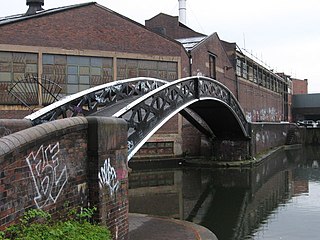
Bordesley is an area of Birmingham, England, 1.2 miles (2 km) south east of the city centre straddling the Watery Lane Middleway ring road. It should not be confused with nearby Bordesley Green. Commercial premises dominate to the west of the ring road, but much of this area is to be redeveloped. Blocks of residential apartments are planned and set for completion from the mid-2020s onwards. The largely residential area east of the ring road was renamed Bordesley Village following large scale clearance of back-to-back houses and redevelopment in the 1980s and 90s. Bordesley is the real life setting of the BBC series Peaky Blinders, and home to Birmingham City Football Club's ground, St Andrew's.
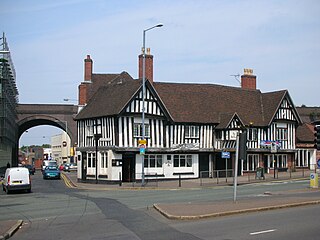
Deritend is a historic area of Birmingham, England, built around a crossing point of the River Rea. It is first mentioned in 1276. Today Deritend is usually considered to be part of Digbeth.

The Victoria Law Courts is a red brick and terracotta judicial building, which accommodates Birmingham Magistrates' Court, on Corporation Street, Birmingham, England. It is a Grade I listed building.

Eastside is a district of Birmingham City Centre, England that is undergoing a major redevelopment project. The overall cost when completed is expected to be £6–8 billion over ten years which will result in the creation of 12,000 jobs. 8,000 jobs are expected to be created during the construction period. It is part of the larger Big City Plan project.

The Warwick Bar conservation area is a conservation area in Birmingham, England which was home to many canalside factories during the Industrial Revolution of the eighteenth and nineteenth centuries.

Charles Edward Bateman FRIBA was an English architect, known for his Arts and Crafts and Queen Anne-style houses and commercial buildings in the Birmingham area and for his sensitive vernacular restoration and extension work in the Cotswolds.

The Digbeth Branch Canal in Birmingham, England is a short canal which links the mainline of the Birmingham and Fazeley Canal at Aston Junction and the Grand Union Canal at Digbeth Junction in Digbeth, a district in Birmingham, England.

Aston Junction is the name of the canal junction where the Digbeth Branch Canal terminates and meets the Birmingham and Fazeley Canal near to Aston, Birmingham, England.
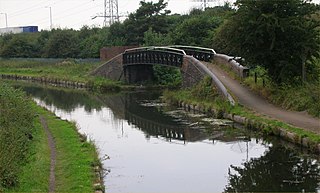
Rushall Junction is the southern limit of the Rushall Canal where it meets the Tame Valley Canal in the West Midlands, England. It opened in 1847, when the Rushall Canal was built to create connections between the Birmingham Canal Navigations system and the Wyrley and Essington Canal, following the amalgamation of the two companies in 1840.

The Lad in the Lane is a pub in the Bromford area of Erdington in Birmingham, England. Dating to the year 1400, it is considered to be the oldest house and pub in the city, although The Old Crown in Digbeth claims to date from 1368, a date which is yet to be confirmed. Prior to the dating of the building, New Shipton Barn in Walmley was considered to be the oldest building in Birmingham, dating to around 1425. To find the construction date of the building, scientists used a technique called dendrochronology to analyse the timbers in the oldest known part of the building. The results showed that it was constructed in the spring at the end of the 14th century.

Birmingham Curzon Street railway station is the planned northern terminus of High Speed 2 on the fringe of Birmingham city centre, England. The new railway will connect Birmingham to London Euston via Birmingham Interchange and Old Oak Common. Curzon Street will have seven terminal platforms and is planned to open in 2026.
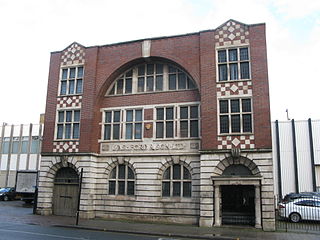
The former Ashford & Sons factory in Birmingham, England is a Grade II* listed building in Arts & Crafts style.